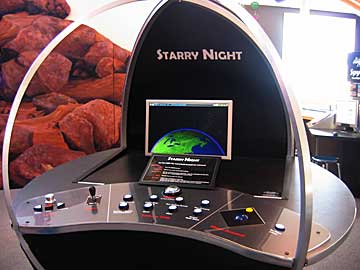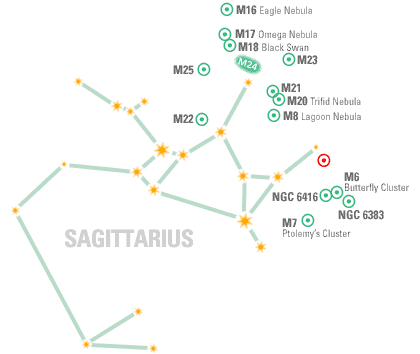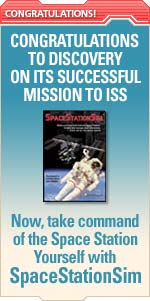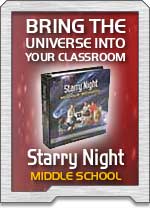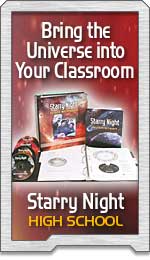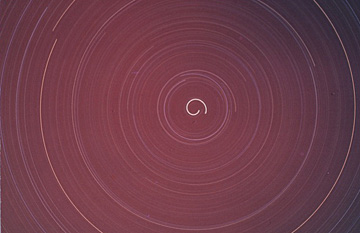 |
|||||||||||||||||||||||||||||||||||||||||||||||||||||||||||||||||
|
If you have trouble viewing this newsletter, click here. Welcome again to our monthly newsletter with features on exciting celestial events, product reviews, tips & tricks, and a monthly sky calendar. We hope you enjoy it!
In our last issue, we alerted you to the impending close passage of near Earth asteroid 2004 XP14. Although many people tried to observe this object, I seem to be one of the few who actually succeeded. Here’s how I managed it. One essential for observing a faint fast moving body is to know exactly where it is going to be. The easiest way to do this is to use Starry Night® to plot its path. The problem with near Earth asteroids is finding accurate up-to-date orbital elements. Because near Earth asteroids pass close to the Earth, their trajectory across the sky is very slight until they are very close, because they are coming pretty well straight at us. This makes it very hard to define their orbit until they are nearly on top of us. Also, because they are small and passing close to large objects like the Moon and the Earth, their orbits are often perturbed at the last moment. The trick is to use the most recent elements calculated just a few hours prior to the pass. The orbital elements in the Starry Night® data files are updated every 24 hours, and are good for almost every object. However, because this asteroid could change quickly, I wanted elements that were updated only a few hours before I went out to observe, so I decided to use elements from the IAU's Minor Planet Centre downloaded a few hours before the pass. All you need to do here is type in the asteroid’s name, in this case “2004 XP14,” tell it (down towards the bottom of the page) that you are using Starry Night®, and click the “Get ephemerides/HTML page” button. In Starry Night®, you choose “New Asteroid Orbiting Sun” from the File menu, and paste the values from the MPC web page into the boxes: To read the rest of this article, click here.
If you think Starry Night® on a 20-inch screen is impressive, imagine it on a 30-foot dome. That dream is no longer far from reality. In the past two years, Starry Night® has collaborated with leading science centers and planetarium makers to bring the visual beauty and accuracy of Starry Night® to larger screens and audiences. In January 2006, the Sciencenter of Ithaca, NY opened the doors to its new interactive exhibit, Mars and Stars, which features a hands-on Starry Night® kiosk. Children can visit astronomical objects such as planets, stars, and nebulae, and see the constellations in our local night sky with the push of a button.
Photo courtesy of Sciencenter To read the rest of this article, click here.
Spitz
Digital
Institute Starry Night® has partnered with Spitz Inc for the second annual Digital Institute, an expanded five-day program in which teachers and planetarium professionals can explore astronomy education, presentation and production techniques using Starry Night® and other digital tools. Courses will cover a broad range of digital planetarium topics from basic techniques and terminology, to advanced lesson creation with 3D simulation software and advanced-user sessions. The Digital Institute will focus on using software to enhance education in both the classroom and the planetarium, with a particular emphasis on the following critical areas:
The Institute is divided into two parts. The first two days (August 15-16) are open to any teacher or planetarium professional interested in teaching with Starry Night®. Courses focus on how Starry Night® is used to bridge classroom astronomy education with planetarium presentations. Educators work with Starry Night®'s existing lesson plans and develop their own activities. To read the rest of this article, click here. Starfest Canada's largest annual observing convention and star party celebrates its 25th anniversary this August. Sponsored by the North York Astronomical Association, it attracts over 1,000 astronomy enthusiasts from Ontario, and neighboring provinces and states. It has been ranked among the top seven star parties in North America by Sky & Telescope magazine. Starfest offers a wide variety of observing-oriented activities that address the needs and interests of experienced observers and astrophotographers, as well as those new to the hobby. Activities include observing sessions, formal and informal presentations, workshops, commercial exhibits, and a children's program. You are invited to bring your telescope and astronomical images, and share your observing experiences with others. To read the rest of this article, click here.
Neptune spends most of the year in the constellation Capricornus. On August 11th it reaches opposition and, although low in the sky, this marks the best time to observe the eighth planet from the Sun.
At Neptune’s distance, the Sun appears less than 4% as bright as it does at Jupiter. So Neptune is invisible from Earth to the naked eye and a challenge to detect even with a good pair of binoculars. At magnitude 7.7 and featuring a very tiny (2.5 arc-second) bluish disc, at least a six-inch telescope and a magnification of 150x are required to reveal it as a planet. Neptune’s largest moon, Triton, shines with a magnitude of 13 and can be glimpsed in a six-inch telescope but only under near-perfect conditions. Pedro
Braganca
M6 and M7, two open clusters, are bright and obvious in Sagittarius, and make for easy binocular objects. Telescopes open up both in rich detail and M6 is seen to be aptly named "The Butterfly Cluster". NGC 6416 is a small open cluster and NGC 6383 is a dim, wide cluster with nebulosity. M8 "The Lagoon Nebula" is the brightest nebula after the great Orion nebula. It's actually more massive than M42 but is farther away: 4,500 lightyears distant compared with 1,500 lightyears. M8 is best viewed with a wide-field eyepiece. Less spectacular, but still worth some time, M20 "The Trifid Nebula" is also easily seen in binoculars; a telescope will bring out the dust band that gives the nebula is shape and name. M21 is a small rich open cluster in the same field of view as M20. M23, excellent in small scopes, is an open cluster seen in binocs, as is M25. M24 "Delle Caustiche" is a large and lovely "frothy" looking region seen easily in binoculars. It's actually part of the Milky Way and only stands out as a distinct patch because, like M23 and M25, it sits in front of a dark nebula that obscures our line of sight to the core of the galaxy. (By the way, the very center of our galaxy is marked above with a red target symbol.) M22 is a sweet globular cluster, the third-brightest in the sky. Populated by half a million stars, it's distant by a mere 10,000 lightyears, making it the nearest glob to Earth. M16 and M17 are two nebulae, the latter in particular a rewarding target. M16, however, is notable for being the location of "The Pillars of Creation" the iconic image produced by the Hubble Space Telescope. M18 "The Black Swan" is a pretty open cluster with about 40 members, surrounded by fainter background stars in the band of the Milky Way. Sean
O'Dwyer
|
August 2006
|
||||||||||||||||||||||||||||||||||||||||||||||||||||||||||||||||
|
24-hour Star Trails This month’s winning photo was taken by Earl Moser from Hickman, Nebraska (submitted by daughter - Leona Barratt , Lincoln, Nebraska). Earl writes:
PHOTO OF THE MONTH COMPETITION: We would like to invite all Starry Night® users to send their quality astronomy photographs to be considered for use in our monthly newsletter. Featured submissions (best of month) will receive a prize of $25 USD. Please read the following guidelines and see the submission e-mail address below.
|
|||||||||||||||||||||||||||||||||||||||||||||||||||||||||||||||||
 |
|||||||||||||||||||||||||||||||||||||||||||||||||||||||||||||||||
|
|
|||||||||||||||||||||||||||||||||||||||||||||||||||||||||||||||||
You
have
received
this
e-mail
as
a
trial
user
of
Starry
Night®
Digital
Download
or
as
a
registrant
at
starrynight.com.
To
unsubscribe,
click
here.

